The Highest-End Notebooks, 2009
by Jarred Walton on October 14, 2009 3:10 AM ESTGaming Performance
Here are the complete gaming results, using 1680x1050 as the baseline for comparison with other laptops. We're including the ASUS W90Vp (Core 2 Q9000 @ 2.20GHz with 4870X2), Clevo D901C (Core 2 E6850 with 8800M GTX SLI), and a desktop system (Q6600 @ 3.30GHz with 4870X2) as a point of reference.
We include the native resolution results for each LCD as well, which means HD+ (1600x900) for the W870CU, 1080p (1920x1080) for the M980NU, and WUXGA (1920x1200) for the D900F. In some cases, we run into CPU limitations; this will be apparent when both 1680x1050 and the native resolution deliver similar results. This is most likely to occur with the M980NU SLI configuration, but it may be present elsewhere. 1680x1050 has 22.5% more pixels than 1600x900, 1920x1080 has 17.5% more pixels than 1680x1050, and 1920x1200 has 30.6% more pixels than 1680x1050. If we are purely limited by the number of pixels the GPU(s) can render, we will see similar scaling to these percentages. Most of the time, other factors such as GPU memory bandwidth, GPU geometry, and CPU performance will also influence the frame rates.
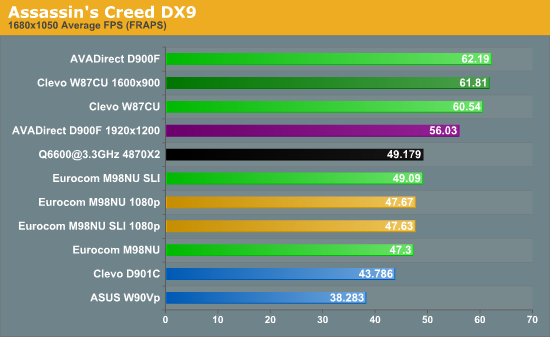
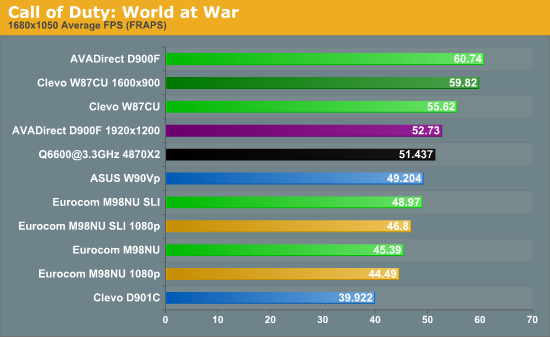

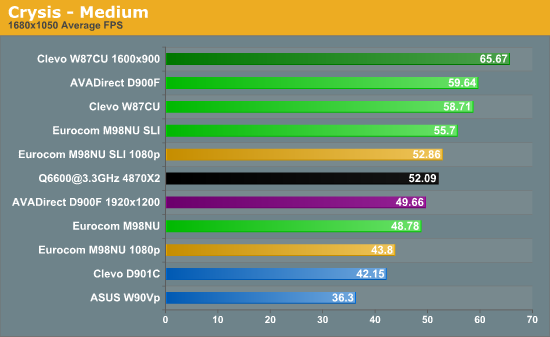
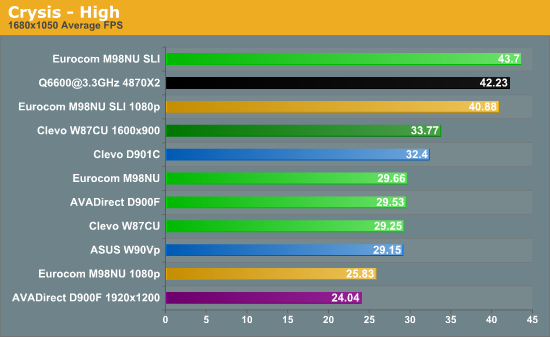
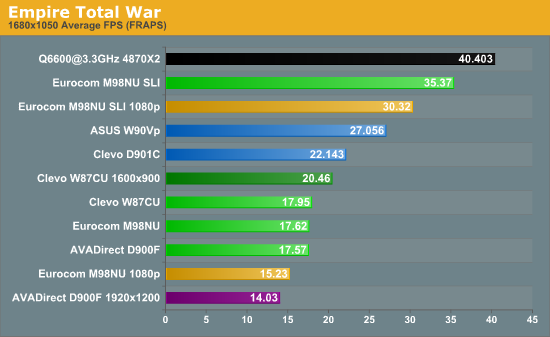
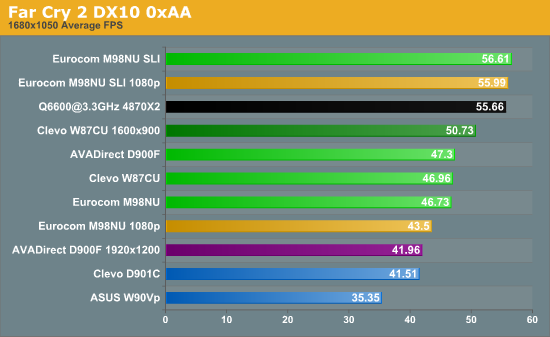
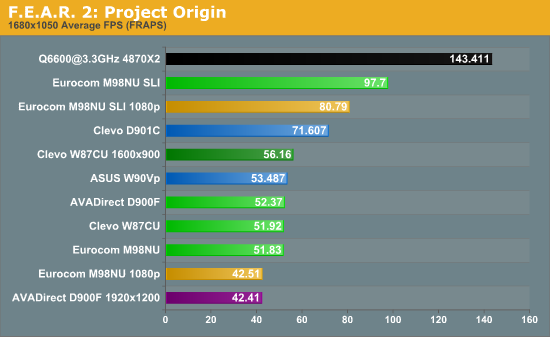
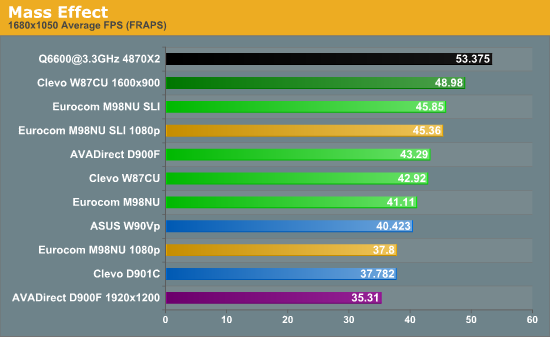
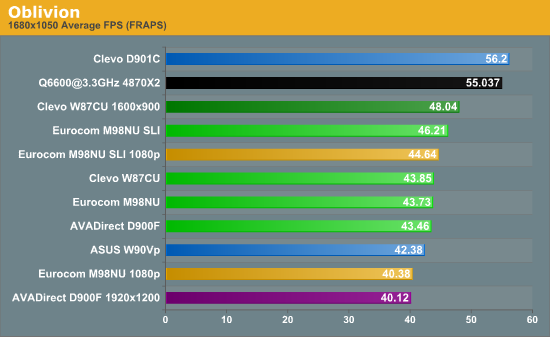

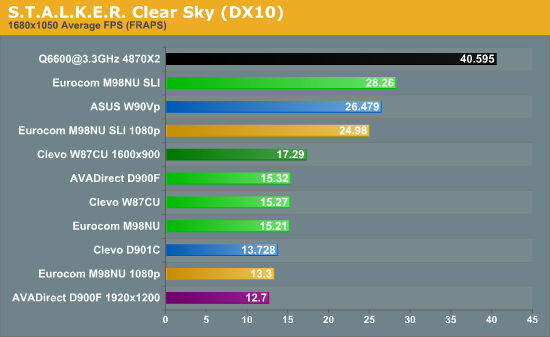
Gaming performance is about what you would expect for the most part, with the Eurocom M980NU taking top honors among the notebooks in the majority of games. However, there are definitely games where we are CPU limited with GTX 280M SLI. Assassin's Creed is the most obvious example, showing essentially no difference between SLI and single GPU mode, other than a slight increase in performance with SLI at 1680x1050. Call of Duty: World at War doesn't appear to scale very well with SLI at present -- whether this is a CPU limitation or a lack of updated SLI profiles isn't entirely clear. Crysis also appears to be running into CPU limitations, particularly at medium detail settings. Far Cry 2 with SLI could benefit from a faster CPU, and so could Mass Effect, Oblivion, and Race Driver: GRID.
On the other side of the table, we have games that scale extremely well with SLI. Dark Athena is almost completely GPU limited, along with Empire: Total War, F.E.A.R 2, and STALKER: Clear Sky. One of the interesting points is that the HD+ resolution on the W870CU is beneficial in several titles, with performance scaling almost linearly with the decrease in resolution. Any of the GPU limited titles we just mentioned should fall into this category.
On a final note, it's interesting to compare performance between the desktop system and these gaming laptops. We have to account for the fact that we are comparing ATI and NVIDIA hardware, which can definitely influence the results, but a system that now qualifies as a "midrange desktop" still comes out on top in the vast majority of these games. The only place where the desktop doesn't lead is in CPU limited titles (Assassin's Creed, Call of Duty, Crysis, and Far Cry 2), while in other titles the lead is substantial. Something the results don't show is how much easier it is to get updated drivers for the desktop. NVIDIA is doing better now with mobile reference drivers coming out quarterly, and sometimes even more frequently, but you can easily find updated desktop drivers every month for ATI cards, and just about as often for NVIDIA cards if you're willing to use beta drivers. It's possible to install unofficial beta drivers on laptops, but our experience is that performance often drops dramatically since they don't have all of the mobile hardware optimizations in place -- and don't even bother with unofficial drivers on SLI notebooks.










56 Comments
View All Comments
JarredWalton - Thursday, October 15, 2009 - link
I think LAN party goers is a far smaller market than CAD/CAM companies that need a mobile workstation, personally. I'd also say military gamers that are deployed would be more than LAN attendees (though that might be close). I've also heard of professional athletes getting something like this, but they're a VERY small niche. LOLkagey - Monday, October 19, 2009 - link
I appreciate the review and like to see these plus other laptop ODMs rather than just Sony, Dell, HP, etc.You have hit it right on the head, it's a niche market. They are DTR machines, that are portable but not without a plug-in sooner than later (within 45-60 mins).
Having a Sager NP9850 and the 3000 price tag that goes with it, I can say it has its pro's and con's but for what it's used for it was worth it. It could of been cheaper (always)!!! Buying a desktop or mATX was not an option for the portability that's necessary. Who'd lug around an LCD, not I. Build quality compared to other laptops I've owned is hands down better. Swaping CPUs (which I've done cause I had a better one), GPUs or HDD, ram, without taking the who machine apart is a 1000 times easier. All MFRs are getting better but some are there already.
As far as the LCD (glossy), yes there's glare at times and it can be a pain. I do like the LCD more than any other laptop I've owned to date plus the 18.4 inch screen is huge. I haven't owned an LED LCD yet though, maybe next. This laptop does fit into a Targus backpack XL617 as well plus you do get a workout carrying (i.e. lugging) it around.. lol. Yes it's about 15 lbs all said and done carrying it.
I don't regret the purchase as it's serving the purpose. .02 cents
FXi - Thursday, October 15, 2009 - link
Very, very pleased that you included a mainstream desktop machine in the tests. It really is important that people get a sense of perspective before they spend this kind of money. You have to "need" or "want" portability badly for the cash to performance outlay.That said Intel really kind of did Clarksdale a bit backwards.
The quads should have come next spring and been 32nm and the dual's should have been 45nm and introduced first. I'll never understand why they reversed that.
They really needed to hit basic clock parity with the QX9300. Yes the 920 is faster, but it doesn't set enough distance between itself and it's older cousin. That leads to comparisons like this article and a lot of soul searching between "new" vs "old" design purchase decisions.
It is also almost unfathomable why they didn't include USB 3.0 in the PM55 spec. Intel is a founding member of the coalition the developed the spec. USB changes come around every 5-10 years, so getting 10x the speed of USB 2.0, lower CPU utilization in the process, makes this a kind of must have item. In desktops it doesn't matter as much because you can just throw in a pci-e card and get USB 3.0 whenever you feel like it. But for a laptop, USB is THE way it does most of it's communicating with the outside world. How fast and efficient (and how numerous) those USB ports are is a really big deal on notebooks. To have introduced a "high end" Quad core system and to have foregone this basic 10x increase in outside world communication is like delivering a Ferrari with 70 series tires on it. Great engine, great looks but missing a key component of how it talks to the road. It really is a feature that should not have been left out, no matter what delay it took to get it included.
Faster 32nm Clarkdale, at least 2.53 base speed on all 4 core operation.
USB 3.0 IN the Intel chipset, not as an add in chip.
SLI designs and hybrid Intel IGP or low end integrated GPU for power savings when simply surfinng.
M6400 designs, not M17x garrishness or Clevo "chicklet" keyboards we got rid of in the 80's.
These are a few of the things that "should" have been in systems aimed at the audience that can afford these things. What we got isn't the above. And lack of sales will be blamed on the economy rather than the real issue, "a failure to successfully innovate".
$.02
Pirks - Wednesday, October 14, 2009 - link
It's like four times cheaper to build a mATX box and throw it in your car with a nice 22" LCD monitor whenever you gotta go somewhere. Same "mobility" as these behemothbooks, but with better hardware, and less money wasted.I mean if you're rich these are totally normal ones, why not waste a few grand here and there, but for practical not rich middle class people who look for price/performance/mobility balance these are poor choices.
I wasted almost $2k on an Alienware M17 and probably will never do it again. It's working great and everything, games are flying light speed and all, but every time I think I could get much better hardware for $1k I feel uneasy... with the same mobility as this box, that needs power outlet anyway... nah, these gamebooks are a mixed bag, I'll probably go for cheapo 17" Dell next time + my own mATX box, that's for me is as portable and "mobile" as all these Alienwares, Clevos and similar fat bricks
InternetGeek - Wednesday, October 14, 2009 - link
These are DTR machines. You buy them because you don't want to have the big clunky box and what not anymore.I for one gave up desktops after buying my DTR. At work I have the work provided workstation and they allowed me to use my own keyboard (ergonomic) and trackball. At home I use my DTR and I'm quite happy with it. When on the move I just use my WinMo and OneNote. That's it. No need to keep hauling stuff around when you realize there's a lot of free services that will let you keep all your PCs synchronized.
I for one use "My Phone" for backing up my info, and the let live have my calendar and emails. Same goes for contacts.
Pirks - Wednesday, October 14, 2009 - link
mATX slim cases are pretty far from being "big clunky", they are somewhat bigger than 12 pound DTR we're talking about, but when you stuff 'em in a bag with 22 incher and K/M there's not a huge difference in weight/size compared to DTR + its humongous power brick + mouse + carrying bag for all that, trust me.InternetGeek - Wednesday, October 14, 2009 - link
Well, just the pic of someone hauling their entire pc around along a 22incher makes me lol. So, if you think that's practical for you go ahead and knock yourself out :).I agree those Clevo machines are huge to the point of missing the point of a laptop. 3 Harddrives, SLI, 18inches. Crazy. You can still get good performance without going all that way in adding crazy hardware like that.
Pirks - Wednesday, October 14, 2009 - link
What's the difference between hauling around huge 12 pound Clevo with its 6 pound power brick versus very small mATX slim desktop case, 22" LCD and K/M? Answer: none or very little. Got my point now?InternetGeek - Wednesday, October 14, 2009 - link
Bluntly put, a DTR is designed to be carried around. The entire set up is made so it can be carried around in a bag. Laptop bags can also play the role of your backpack so you can put books, magazines or whatever you want in them.Carrying around a Desktop PC is done for LAN parties. And even then you try to minimize what you haul. Again, I do think seeing someone carrying around their PC because they can get the Desktop performance/Experience wherever they are funny. I'd love to see that during a Tech event. Pic of the year for sure.
In any case, DTRs have their purpose which I think they cover quite well. Until I got mine I built every single system I had (I built my first PC when I was 12), and to be honest, I think it's an awesome path to try. I would only ask for upgradable GPUs.
JarredWalton - Wednesday, October 14, 2009 - link
Technically, the power brick weighs in at two pounds. I'd say that's a pretty big difference between DTR laptop (15 pounds including a backpack and mouse) and LCD + mATX + backpack + keyboard + mouse. A 22" LCD will weigh about that much on its own, and you need a good backpack for carrying such a display... I don't even know where you'd find one.This is not to say that people should go but DTRs, but if you know the limitations and are okay with that they fulfill a need. I don't think anyone would actually want the task of carrying around a complete mATX system with peripherals if they could avoid it. The only reason to go that route is for performance at the cost of mobility.